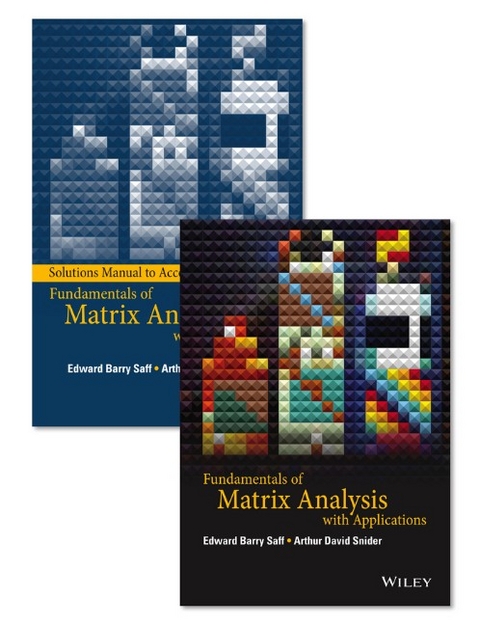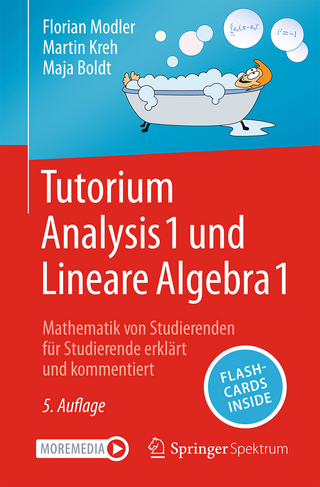
Fundamentals of Matrix Analysis with Applications Set
John Wiley & Sons Inc (Verlag)
978-1-118-99541-9 (ISBN)
Providing comprehensive coverage of matrix theory from a geometric and physical perspective, Fundamentals of Matrix Analysis with Applications describes the functionality of matrices and their ability to quantify and analyze many practical applications.
Written by a highly qualified author team, the book presents tools for matrix analysis and is illustrated with extensive examples and software implementations.
Beginning with a detailed exposition and review of the Gauss elimination method, the authors maintain readers’ interest with refreshing discussions regarding the issues of operation counts, computer speed and precision, complex arithmetic formulations, parameterization of solutions, and the logical traps that dictate strict adherence to Gauss’s instructions. The book heralds matrix formulation both as notational shorthand and as a quantifier of physical operations such as rotations, projections, reflections, and the Gauss reductions. Inverses and eigenvectors are visualized first in an operator context before being addressed computationally. Least squares theory is expounded in all its manifestations including optimization, orthogonality, computational accuracy, and even function theory. Fundamentals of Matrix Analysis with Applications also features:
Novel approaches employed to explicate the QR, singular value, Schur, and Jordan decompositions and their applications
Coverage of the role of the matrix exponential in the solution of linear systems of differential equations with constant coefficients
Chapter-by-chapter summaries, review problems, technical writing exercises, select solutions, and group projects to aid comprehension of the presented concepts
Edward Barry Saff, PhD,?is Professor of Mathematics and Director of the Center for Constructive Approximation at Vanderbilt University. Dr. Saff is an Inaugural Fellow of the American Mathematical Society, Foreign Member of the Bulgarian Academy of Science, and the recipient of both a Guggenheim and Fulbright Fellowship. He is Editor-in-Chief of two research journals,?Constructive Approximation?and?Computational Methods and Function Theory, and has authored or coauthored over 250 journal articles and eight books. Dr. Saff also serves as an organizer for a sequence of international research conferences that help to foster the careers of mathematicians from developing countries. Arthur Da vid Snider, PhD, PE, is Professor Emeritus at the University of South Florida, where he served on the faculties of the Departments of Mathematics, Physics, and Electrical Engineering. Previously an analyst at the Massachusetts Institute of Technology's Draper Lab and recipient of the USF Krivanek Distinguished Teacher Award, he consults in industry and has authored or coauthored over 100 journal articles and eight books. With the support of the National Science Foundation, Dr. Snider also pioneered a course in fine art appreciation for engineers.
Preface
Part I
Introduction: Three Examples
Chapter 1. SYSTEMS OF LINEAR ALGEBRAIC EQUATIONS
1.1 Linear Algebraic Equations
1.2 Matrix Representation of Linear Systems and the Gauss]Jordan Algorithm
1.3 The Complete Gauss Elimination Algorithm
1.4 Echelon Form and Rank
1.5 Computational Considerations
Chapter 2. MATRIX ALGEBRA
2.1 Matrix Multiplication
2.2 Some Applications of Matrix Operators
2.3 The Inverse and the Transpose
2.4 Determinants
2.5 Three Important Determinant Rules
Review Problems for Part I
Technical Writing Exercises for Part I
Group Projects for Part I
A. LU Factorization
B. Two]Point Boundary Value Problems
C. Electrostatic Voltage
D. Kirchhoff's Laws
E. Global Positioning Systems
Part II
Introduction: The Structure of General Solutions to Linear Algebraic Equations
Chapter 3. VECTOR SPACES
3.1 General Spaces, Subspaces, and Spans
3.2 Linear Dependence
3.3 Bases, Dimension, and Rank
Chapter 4. ORTHOGONALITY
4.1 Orthogonal Vectors and the Gram]Schmidt Algorithm Norm
4.2 Orthogonal Matrices
4.3 Least Squares
4.4 Function Spaces
Review Problems for Part II
Magic square
Controllability
Technical Writing Exercises for Part II
Group Projects for Part II
A. Orthogonal Matrices, Rotations, and Reflections
B. Householder Reflectors and the QR Factorization
C. Infinite Dimensional Matrices
Part III
Introduction: Reflect on This
Chapter 5. Eigenvalues and Eigenvectors
5.1 Eigenvector Basics
5.2 Calculating Eigenvalues and Eigenvectors
5.3 Symmetric and Hermitian Matrices
Chapter 5. Summary
Chapter 6. Similarity
6.1 Similarity Transformations and Diagonalizability
6.2 Principal Axes Normal Modes
6.3 Schur Decomposition and Its Implications
6.4 The Power Method and the QR Algorithm
Chapter 7. Linear Systems of Differential Equations
7.1 First Order Linear Systems of Differential Equations
7.2 The Matrix Exponential Function
7.3 The Jordan Normal Form
Review Problems for Part III
Technical Writing Exercises for Part III
Group Projects for Part III
A. Positive Definite Matrices
B. Hessenberg Form
C. The Discrete Fourier Transform and Circulant Matrices
Answers to Odd]Numbered Problems
Index
| Erscheint lt. Verlag | 8.12.2017 |
|---|---|
| Verlagsort | New York |
| Sprache | englisch |
| Maße | 185 x 262 mm |
| Gewicht | 1200 g |
| Themenwelt | Mathematik / Informatik ► Mathematik ► Algebra |
| Mathematik / Informatik ► Mathematik ► Analysis | |
| Mathematik / Informatik ► Mathematik ► Wahrscheinlichkeit / Kombinatorik | |
| Technik ► Elektrotechnik / Energietechnik | |
| ISBN-10 | 1-118-99541-4 / 1118995414 |
| ISBN-13 | 978-1-118-99541-9 / 9781118995419 |
| Zustand | Neuware |
| Informationen gemäß Produktsicherheitsverordnung (GPSR) | |
| Haben Sie eine Frage zum Produkt? |
aus dem Bereich


